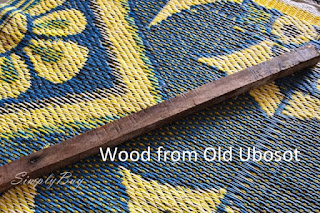Pidta Bangsek with Mahaniyom purpose can be easily distinguished by knowing the attributes and temperament of the master creator. One such master maker of Pidta Mahaniyom in Kelantan is Luang Phor Uwan or Archan A1. His wood crafted Pidta is generally popular with people in doing sales and businessmen. Although the wood Pidta is very popular among LP Uwan's Pidta collectors, we also came across buffalo horns and bones that are made for different purposes by this Kelantan master. In this exclusive edition we shall take a glimpse into the making of the famous Pidta Bangsek Mahaniyom by Luang Phor Uwan using a very old piece of hard wood from the temple's Ubosot roof.
 |
| Presumably Chengal wood as it had withstand the test of time. |
Before we go any further, we took several snapshots of the old Ubosot that's undergoing some minor repairs. With permission given we went to take a look inside this old building.
Upon entry at the far end is an altar for prayers. The cozy space inside this dwelling place is made from wood except the center courtyard. Very neat and tidy despite the signs of ageing. A very nostalgic feeling as though one travels back to the past by imagining the life of monks in the old Siamese Kelantan days.
Majority of old building architecture here are similar to traditional Malay kampong houses that are raised up with concrete beams because the annual monsoon flooding is common here in Kelantan. Coming back to the main topic before this batch of special request Pidta can be ready for use and taken home are the remaining last few steps.
 |
| An electric drill was used to make a hole onto the solid Pidta. |
 |
| Writing "Khom" scripts |
 |
| Inserting the Katha "Khom" scroll into the base of Pidta. |
 |
| Closer view of the scroll insertion |
 |
| After inserting the Katha scroll, the base is then sealed with glue to permanently retain the scroll inside the Pidta. |
 |
| Final touches to smooth out the remaining rough edges on each Pidta. |
The entire process is coming to the final stage of chanting before these Pidta Mahaniyom can be taken away and follow us home. LP Uwan chanted sacred texts to the Pidta as though like telling them in an alien language that is neither Malay or Thai. A very unique incantation chanting presumably Khmer language. After the chanting LP Uwan blessed us the receiver with holy water.
Each and every Pidta is not similar in terms of size as they are all handmade with carving knives and other carpentry hand tools. Some maybe lighter in color depending on the wood grains. Irregardless of its non-standard sizes, for those who are very familiar with LP Uwan's Pidta will certainly know how to visualize his trademark carving style notably the legs and arms of his Pidta.
The specific katha to be used for these batch of Pidta follows Phra Sivali katha. LP Uwan was kind enough to recite his Sivali katha version for me to jot down and be recited when using this Pidta in my daily work.
Namo Tassa Bhagavato Arahato Samma Sambuddhasa x 3 Times
Nacaliti Calitina Litinaca Tinacali
The miraculous Venerable Sivali was one of Lord Sakyamuni Gautama Buddha's highly venerated disciple. He was well-known for his Parami in obtaining assistance from all those surrounding e.g. people or angels in terms of food and requisites wherever he goes. Hence, those days whenever our Lord Buddha wish to travel far distances to teach the profound Dhamma, Venerable Sivali will always be requested to follow along the entourage of monks. All travelling monks will never go hungry or lack of supply whenever Venerable Sivali is around.
This highly sought after sacred wood Pidta by LP Uwan had been on my list for personal collection. With this illustration into the making of this Pidta Bangsek Mahaniyom batch from one of Kelantan's great master in the aspect of Mahaniyom, we hope readers will appreciate this intricate arcane knowledge before this art is vanish in the future.
Sadhu! Sadhu! Sadhu!
Now Playing
Next Article Stories






























No comments:
Post a Comment
Note: Only a member of this blog may post a comment.